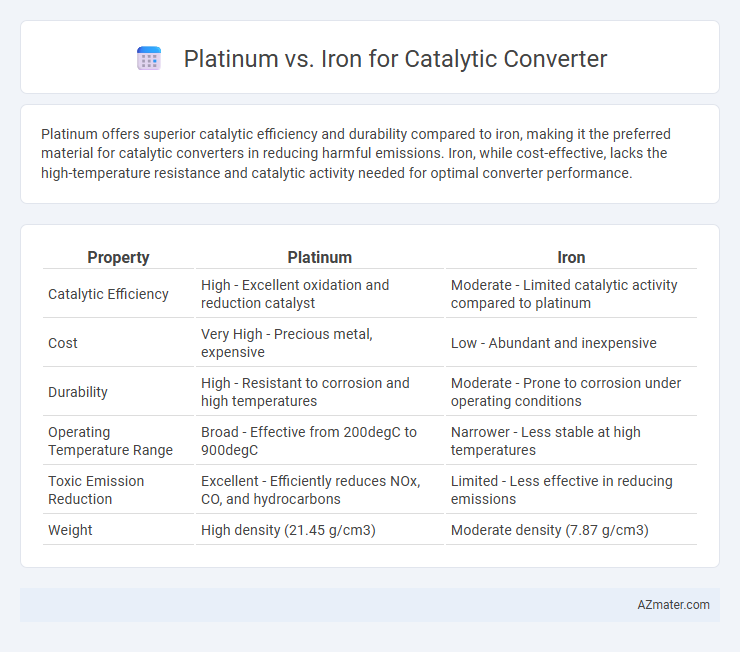Platinum offers superior catalytic efficiency and durability compared to iron, making it the preferred material for catalytic converters in reducing harmful emissions. Iron, while cost-effective, lacks the high-temperature resistance and catalytic activity needed for optimal converter performance.
Table of Comparison
| Property | Platinum | Iron |
|---|---|---|
| Catalytic Efficiency | High - Excellent oxidation and reduction catalyst | Moderate - Limited catalytic activity compared to platinum |
| Cost | Very High - Precious metal, expensive | Low - Abundant and inexpensive |
| Durability | High - Resistant to corrosion and high temperatures | Moderate - Prone to corrosion under operating conditions |
| Operating Temperature Range | Broad - Effective from 200degC to 900degC | Narrower - Less stable at high temperatures |
| Toxic Emission Reduction | Excellent - Efficiently reduces NOx, CO, and hydrocarbons | Limited - Less effective in reducing emissions |
| Weight | High density (21.45 g/cm3) | Moderate density (7.87 g/cm3) |
Introduction to Catalytic Converters
Catalytic converters utilize platinum and iron as key materials to facilitate the conversion of harmful exhaust gases into less toxic emissions, enhancing vehicle environmental compliance. Platinum acts as an efficient catalyst due to its high resistance to oxidation and excellent catalytic properties in converting carbon monoxide, hydrocarbons, and nitrogen oxides. Iron, while less costly, is typically used in combination with other metals but offers lower catalytic efficiency and durability compared to platinum in automotive emission control systems.
The Role of Catalysts in Emission Control
Platinum plays a crucial role in catalytic converters by facilitating the oxidation of carbon monoxide and hydrocarbons into less harmful carbon dioxide and water vapor, due to its high catalytic activity and resistance to poisoning. Iron, while less effective than platinum, can serve as an inexpensive alternative catalyst but generally requires higher temperatures to achieve comparable emission control. The choice between platinum and iron catalysts directly impacts the efficiency and durability of emission control systems in automotive exhausts.
Platinum: Properties and Function in Catalytic Converters
Platinum exhibits exceptional catalytic properties due to its high thermal stability, resistance to poisoning, and superior catalytic activity in oxidation and reduction reactions within catalytic converters. Its ability to facilitate the conversion of harmful gases such as carbon monoxide, hydrocarbons, and nitrogen oxides into less harmful emissions like carbon dioxide, water vapor, and nitrogen gas makes it a critical component in automotive emission control systems. The high melting point and durability of platinum ensure longevity and efficiency, distinguishing it from iron, which lacks comparable catalytic effectiveness and corrosion resistance in catalytic converter applications.
Iron: Emerging Alternatives in Catalysis
Iron is gaining attention as a sustainable and cost-effective alternative to platinum in catalytic converters due to its abundance and lower environmental impact. Recent advancements in iron-based catalysts have demonstrated promising catalytic efficiency and durability in automotive emissions control. Research continues to optimize iron's active sites and enhance resistance to poisoning, positioning it as a viable contender in next-generation catalytic technologies.
Efficiency Comparison: Platinum vs Iron
Platinum exhibits significantly higher catalytic efficiency than iron in catalytic converters due to its superior activation energy reduction and durability under high-temperature exhaust conditions. Iron catalysts typically require larger quantities to achieve similar conversion rates of harmful gases like CO, NOx, and hydrocarbons but suffer from faster deactivation and lower thermal stability. The enhanced performance of platinum results in improved emission control and longer catalyst lifespan, making it the preferred choice despite higher material costs.
Cost Analysis: Platinum vs Iron
Platinum is significantly more expensive than iron, with platinum prices averaging around $1,000 per ounce compared to iron's cost of mere dollars per ton, heavily impacting catalytic converter production costs. The high cost of platinum, driven by its rarity and demand in automotive applications, makes iron an attractive alternative despite its lower catalytic efficiency. Cost analysis reveals that while platinum-based converters offer superior durability and performance, iron-based catalysts can dramatically reduce material expenses, influencing manufacturers' choices in balancing cost and effectiveness.
Environmental Impact of Platinum and Iron Usage
Platinum, widely used in catalytic converters, offers superior catalytic efficiency in reducing harmful emissions such as carbon monoxide, hydrocarbons, and nitrogen oxides, contributing to lower air pollution levels. However, platinum mining and refining have significant environmental drawbacks, including habitat disruption, high energy consumption, and toxic waste generation. In contrast, iron-based catalysts present a more sustainable alternative with lower environmental extraction impacts, although they generally exhibit less catalytic performance and durability compared to platinum.
Longevity and Durability in Real-World Applications
Platinum catalysts in catalytic converters offer superior longevity and durability compared to iron-based alternatives due to their higher resistance to thermal degradation and corrosion under high-temperature exhaust conditions. Real-world applications demonstrate that platinum maintains catalytic activity over extended mileage, reducing the frequency of replacement and ensuring consistent emission control. Iron catalysts, while cost-effective, tend to deteriorate faster, leading to decreased performance and increased maintenance costs in automotive emission systems.
Future Trends: Innovations in Catalytic Converter Materials
Platinum remains the premier catalyst material for catalytic converters due to its exceptional durability and high catalytic efficiency in reducing harmful emissions. Emerging research in nanotechnology and alloy compositions is driving innovations that enhance the performance of iron-based catalysts, aiming to reduce costs while maintaining effective emissions control. Future trends indicate a shift towards hybrid catalyst systems combining platinum and iron to balance economic feasibility with environmental sustainability.
Conclusion: Selecting the Optimal Catalyst
Platinum offers superior catalytic efficiency and durability for catalytic converters due to its higher resistance to poisoning and thermal degradation compared to iron. While iron is significantly cheaper and more abundant, its lower catalytic activity and susceptibility to oxidation reduce long-term performance in exhaust treatment. Selecting platinum as the catalyst ensures optimal emissions control and longevity, justifying its higher initial cost in automotive applications.

Infographic: Platinum vs Iron for Catalytic converter
 azmater.com
azmater.com